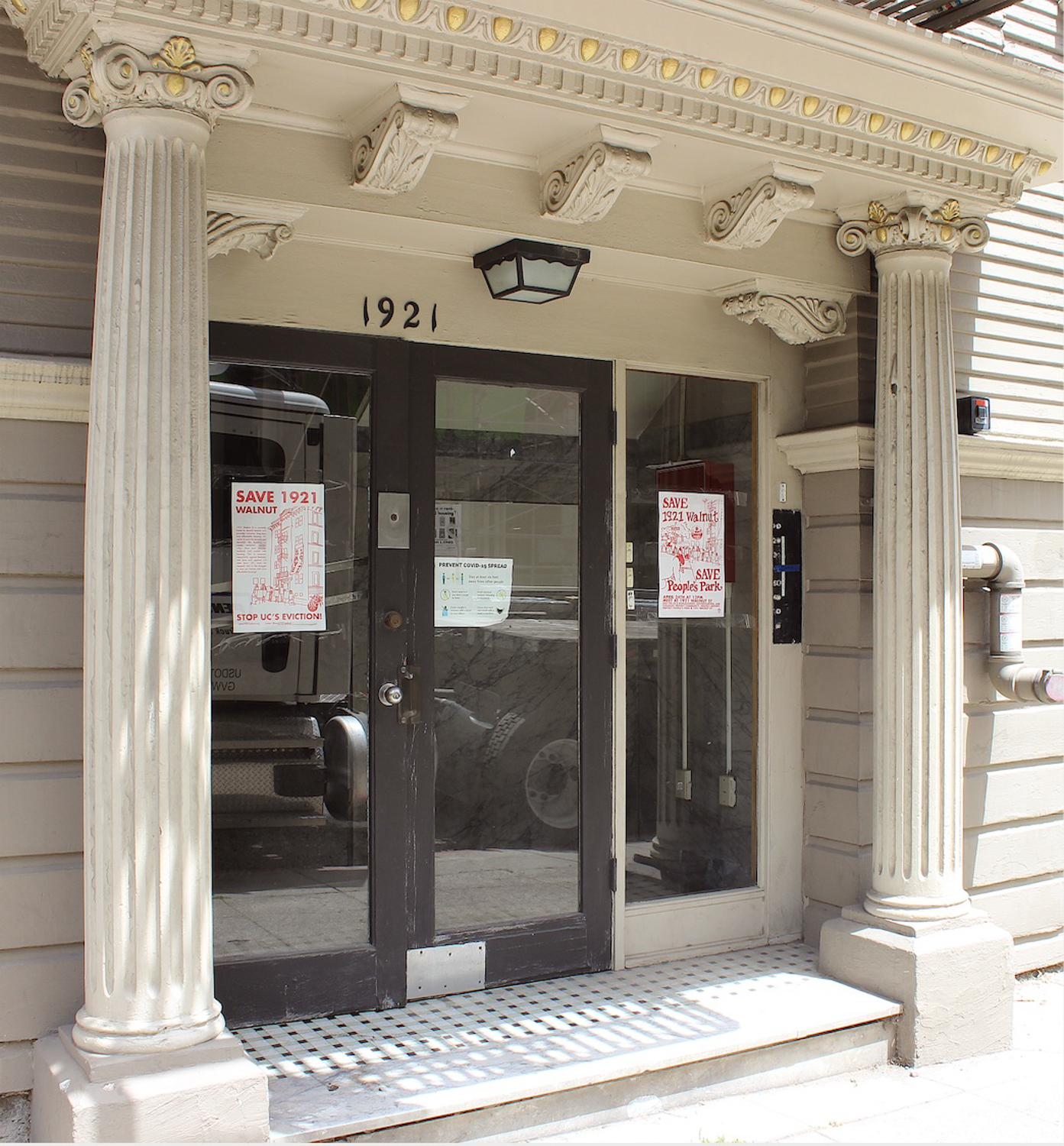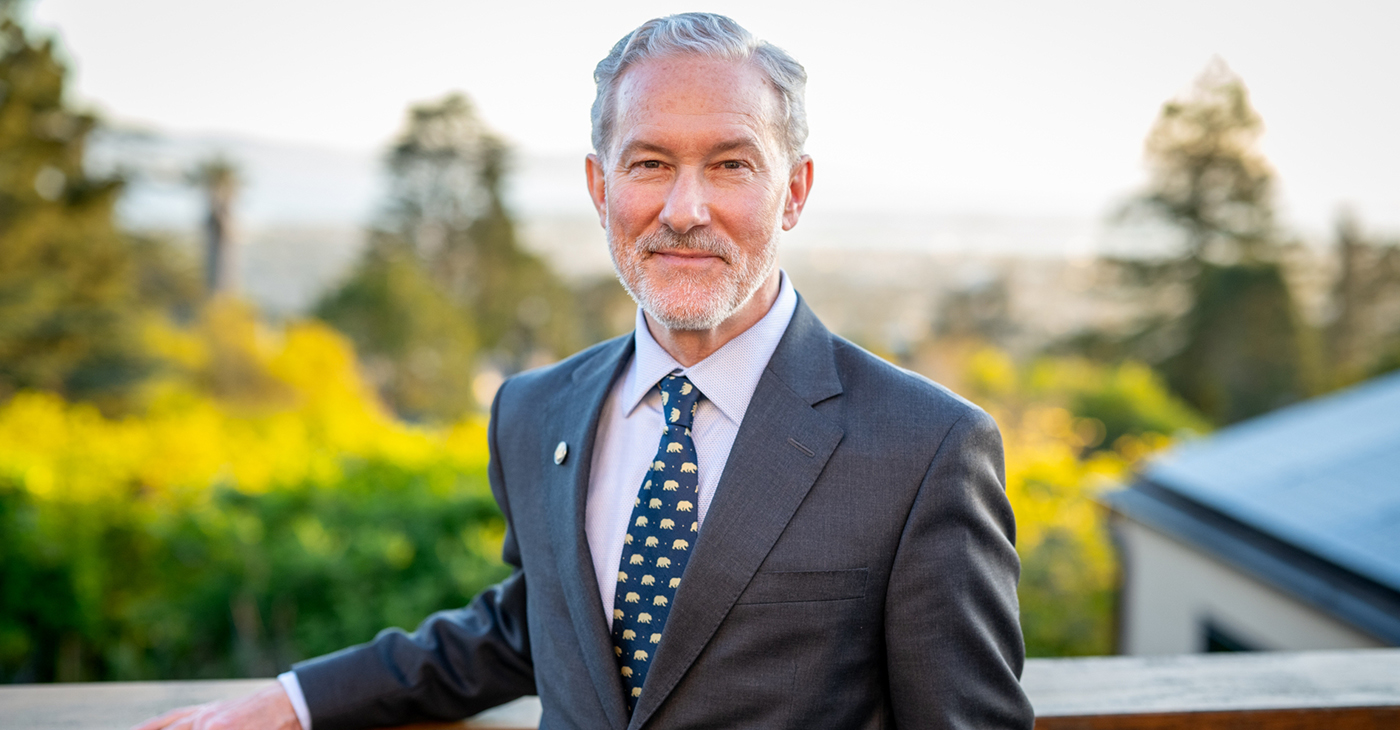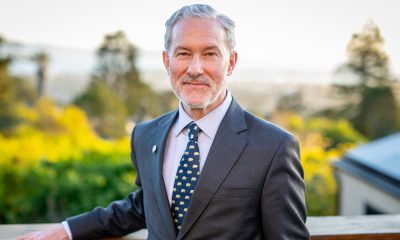Berkeley
Facing Eviction, Tenant Sues UC Regents to Release Public Records
In a letter sent in August last year to Logusch, Wallace, and other 1921 Walnut Street tenants, UC Berkeley Real Estate Director Michelle De Guzman wrote, “The University will not be holding in-person or virtual conversations regarding the property for the foreseeable future.”

Tenant Natalie Logusch is suing the UC Board of Regents to demand they release public records she requested about a year ago related to UC Berkeley’s demolition and development plans that could displace her and her neighbors from their apartments at 1921 Walnut St.
“The public has to know the truth about what the plans are,” said Logusch. “The UC thinks they can push this through by withholding information.”
According to Kyle Gibson, Communications Director for UC Berkeley Capital Strategies, Logusch could receive the records soon.
“The university is discussing a settlement of the lawsuit with Ms. Logusch’s counsel that includes production of documents,” he said. “We hope this matter will be quickly resolved.”
For Logusch, suing to get the UC Regents to release their records is part of the broader effort to save her and her neighbors’ homes. Paul Wallace, another Walnut Street tenant, said that by not releasing the records, UC is “keeping us [tenants] in the dark.” According to Wallace, he and his neighbors have requested meetings with the university about the development that could displace them, both on their own and through Berkeley’s student union, the ASUC, but the university has always refused.
In a letter sent in August last year to Logusch, Wallace, and other 1921 Walnut Street tenants, UC Berkeley Real Estate Director Michelle De Guzman wrote, “The University will not be holding in-person or virtual conversations regarding the property for the foreseeable future.” At a meeting with the UC Regents during May of this year, UC Berkeley Chancellor Carol Christ claimed the university has initiated “hundreds of hours of community engagement” related to the Long Range Development Plan, which includes Walnut Street’s redevelopment. According to Wallace, however, the university has never met with him and other tenants in his building, and the only avenue he has had for the Regents to hear his concerns has been to call into their meetings and make public comments that are limited to one minute.
“You want to appeal to keep your home, but you only have a minute to do it,” he said. “It’s ludicrous.”
Logusch and Wallace are two of seven tenants, including one child, who currently live in the 112-year-old apartment building on 1921 Walnut St, next to UC Berkeley’s campus. These tenants have lived there from between six and over 25 years. In April last year, the university delivered a letter to the Walnut Street tenants telling them the Regents planned to demolish and redevelop the property they live in. While the letter stated there was “no imminent action planned,” it stressed tenants, who would be offered a relocation plan, could be forced to leave after being given 90 days’ notice.
In July 2020, the UC Regents purchased the Walnut Street building from its previous owner, Waterbury Properties. Since the housing units were covered under rent control, City of Berkeley law had limited the amount that Waterbury Properties could raise the rent on the building per year. But the tenants may have lost these protections when UC Berkeley purchased the property.
“UC Berkeley is exempt from any local zoning and housing ordinances,” said John Selawsky, a Berkeley Rent Board Commissioner. “In terms of state and local law that makes them a sovereign entity.”
Due to local and state laws that cover the City of Berkeley, if a private developer demolished and then rebuilt housing on the same property, as UC Berkeley plans to do, they would have to relocate tenants and then provide them with a right to return. If they demolished rent controlled units, they would have to rebuild the same number of units at a lower-than-market-rate rental price. But these laws do not apply to UC Berkeley.
“These current tenants could lose housing,” said Selawsky. “But Berkeley could also lose a rent controlled building forever. There’s no provision for replacement that UC has offered. And that galls me.”
According to UC Berkeley, the plan is to demolish the building as part of a broader plan for the area to build student housing for transfer students. The project is called Anchor House. The university claims Anchor House will allow 244 apartments with 772 individual bedrooms to be built, funded by donations from a private donor. Gibson claims that demolishing the Walnut Street building will allow 75 students to be housed and that revenues the project generates “will go toward providing annual scholarships for students from underrepresented populations and first generation college students.”
The current Walnut Street tenants disagree with UC. Their website describes the project as “high-end student housing with luxury amenities.” They discovered through a public records request that Jaclyn Safier heads the foundation that is financing the project, and have questioned her intentions after learning she is a billionaire who made at least 13 donations to the Republican Party and National Committee in 2016. They note that the Anchor House plan includes 17,000-square-feet of commercial retail space that can be leased to non-UC vendors and amenities such as a dorm lounge and a teaching kitchen with a scullery. They think there could be enough space for student housing and for their apartments to remain if the plan did not include such additional spaces and amenities.
The Walnut Street tenants feel they have wide support for preserving their rent controlled apartments. The Berkeley Architectural Association recently released a 161-page report agreeing that the existing apartments could be saved if the university reduced some amenities and removed the commercial spaces from the Anchor House plan. A section of the tenants’ website lists supporters including The Sierra Club, UC Berkeley staff and students, and Bay Area Tenants and Neighborhood Councils. Berkeley’s Rent Stabilization Board sent a letter on June 8 last year calling for the building to be preserved, and Berkeley’s City Council unanimously passed a resolution called “Support the Preservation of 1921 Walnut Street” on July 28 of the same year.
On March 18 this year, Berkeley Mayor Jesse Arreguín spoke at a rally in support of the Walnut Street tenants, saying “We need more student housing, but it cannot happen by eliminating existing affordable housing.”
UC Berkeley has its own supporters. The website for Anchor House shows a letters of support from the Downtown Berkeley association, San Francisco Housing Action Coalition, and the Berkeley Chamber of Commerce. They also list support statements from four transfer students. Alice Waters, the founder of Chez Panisse restaurant and a 1967 UC Berkeley graduate, is quoted praising the Anchor House plans, and specifically the kitchens and gardens it could accommodate.
Spokespeople for UC Berkeley and Chancellor Christ have also repeatedly described the relocation package they are offering tenants as “generous.” The Regents are offering rental assistance for three-and-a-half years in another apartment they deem as a “comparable dwelling unit” to where the tenants currently live by paying the difference each month between what tenants currently pay, and what the new unit’s rental price would be. The tenants see this as only a temporary fix, claiming that after three and a half years, when the assistance ends, they will no longer be able to afford the new units. While the Regents have also offered a lump sum option to tenants, the tenants say it is not enough to pay for a mortgage in Berkeley.
Wallace is unhappy with the exit package and fears what will happen if he is displaced from his home. “I’ll be driven out of California,” he said, “or certainly Berkeley.”
Facing limited legal options to stop the destruction and redevelopment of the stie, tenants and their supporters have turned to protest. Shortly after the tenants received the letter informing them of the university’s plans in April of last year, they formed the 1921 Walnut Street Association, which included all tenants in the building except one, totaling about a dozen tenants. Some tenants have since left the association after moving from the area.
The association has regularly written letters, commented in public meetings, and launched twitter campaigns. They organized four large protests that have attracted public figures, local politicians and activists. During one protest, on April 24 this year, about 100 people came out to support the tenants, marching from the 1921 Walnut Street to People’s Park, the location of another site of UC proposed development for student housing that has faced pushback from the local community.
One request for public records that Logusch is currently suing to have released asks for all public comments in response to the UC’s development plans and preparation and environmental impact reports related to the Walnut Street project. Releasing those comments, she said, could allow her to build a stronger movement by finding other supporters interested in saving the Walnut Street apartments.
“Who are the other people who oppose this?” Logusch said. “I have no idea because UC won’t put that information out there. And that’s probably part of the reason they haven’t released the records.”
In her case, Logusch v. The UC Regents, Logusch’s lawyer, Sara B. Kohgadai, accuses the Regents of violating California’s constitution by withholding public records. The case states that the California Public Records Act requires the UC Regents to determine if they have records within 10 days and that the determination period can only be extended to 14 days. Since Logusch initially filled the requests, on June 24 last year, the UC Regents have never formally stated whether it had the records Logusch requested or provided a reason why withholding the records was subject to exemption. Instead, the Regents responded to Logusch’s follow up emails with the same form letter on three separate occasions, which attributed delays in responding to the coronavirus.
“Judging from its form communications,” wrote Kohgadai in the case, “it appears [the UC Regents] violates these duties as a matter of course.”
When asked why the UC Regents has not already released the public records, UC Berkeley Capital Strategies Communications Director Kyle Gibson claimed that several other people requested the same documents around the same time as Logusch, that the Regents responded to those requests, and “believed [she] was among those who received the documents, but inadvertently she was not.”
Whether or not Logusch receives the documents, she is determined to keep organizing with her neighbors and their supporters to save her home.
“I will fight this every way I can,” she said. “This is my home. I am not going quietly. I will not let them displace me.”
Bay Area
Rich Lyons, Longtime Campus Business, Innovation Leader, Will Be UC Berkeley’s Next Chancellor
Rich Lyons, an established economist, former dean of the Haas School of Business and the campus’s current leader for innovation and entrepreneurship, will become the next chancellor at the University of California, Berkeley, the UC Board of Regents announced on April 10.

By Jason Pohl
Rich Lyons, an established economist, former dean of the Haas School of Business and the campus’s current leader for innovation and entrepreneurship, will become the next chancellor at the University of California, Berkeley, the UC Board of Regents announced on April 10.
The board’s unanimous confirmation makes Lyons, 63, the first UC Berkeley undergraduate alumnus since 1930 to become the campus’s top leader. In an interview this week, Lyons said he credits his Berkeley roots and his campus mentors with encouraging him to ask big questions, advance institutional culture and enhance public education — all priorities of his for the years to come.
Lyons, who will be Berkeley’s 12th chancellor, will succeed Chancellor Carol Christ, who announced last year that she’d step down as chancellor on July 1.
“I am both thrilled and reassured by this excellent choice. In so many ways, Rich embodies Berkeley’s very best attributes, and his dedication to the university’s public mission and values could not be stronger,” Christ said. “I am confident he will bring to the office visionary aspirations for Berkeley’s future that are informed by, and deeply respectful of, our past.”
Rising through the Berkeley ranks
Born in 1961, Lyons grew up in Los Altos in the early days of the Silicon Valley start-up boom.
He attended Berkeley, where he graduated in 1982 with a Bachelor of Science degree in business and finance. Lyons went on to earn his Ph.D. in 1987 in economics from MIT. After six years teaching at Columbia Business School, Lyons returned west, where in 1993 he joined the Berkeley faculty as a professor of economics and finance, specializing in the study of international finance and global exchange rates.
He’s remained on campus since, with one notable exception.
Starting in 2006, Lyons spent two years working at Goldman Sachs as the chief learning officer. It was a period that instilled in him an appreciation for leadership and the importance of organizational culture.
He carried those lessons with him when he returned to campus in 2008 and became the dean of the Haas School of Business.
While dean, Lyons oversaw the construction of Connie & Kevin Chou Hall, a state-of-the-art academic building that opened in 2017 and is celebrated for its sustainability. He also helped establish two new degree programs, linking the business school with both the College of Engineering and the Department of Molecular and Cell Biology.
But it was his creation of four distinct defining leadership principles that spurred a sweeping culture initiative at the school that stands out in the minds of many. Those values — question the status quo, confidence without attitude, students always, and beyond yourself — became a creed of sorts for new students and alumni alike.
Those values are important, Lyons said, because they shape and support the cohesive structure of a strong, connected community — spanning science and technology to the arts and humanities. They also convey the story about what it means to be at Berkeley and to believe in the university’s public mission.
“When we are great as educators, it’s identity-making,” Lyons said. “We’re helping students and others see identities in themselves that they couldn’t see.”
Lyons in January 2020 became Berkeley’s first-ever chief officer of innovation and entrepreneurship.
Building on his research exploring how leaders drive innovation and set behavioral norms and culture, Lyons worked to expand and champion Berkeley’s rich portfolio of innovation and entrepreneurship activities for the benefit of students, faculty, staff, startups and external partners.
It was a major commitment to thinking outside the box, he said. One need only look to the Berkeley Changemaker program that he helped launch in 2020 to see innovation and entrepreneurship in action.
The campuswide program with some 30 courses tells the story of what Berkeley is — the story that members of the Berkeley community can tell long into the future. Berkeley Changemaker started as an idea and its courses quickly became among the most popular academic offerings on campus.
“Over 500 students showed up,” he said. “Why? Because it’s a narrative. It’s not just a name. It’s not just a curriculum. It’s not just a course. It’s a way of living, and it’s a way of living that Berkeley has occupied forever. This idea that there’s got to be a better way to do this, question the status quo.”
Activism
Oakland’s ‘Green the Church,’ Others, Host a Climate Revival
On April 20, Oakland’s Green The Church California (GTC) and the Center For Food, Faith and Justice will celebrate Earth Day and present a Climate Revival event titled “Growing Healthy Communities From Soil To The Soul” at McGee Avenue Baptist Church at 1640 Stuart St, Berkeley, CA. The day will include inspiring talks, interactive workshops, networking opportunities, and a special panel on Food Sovereignty and Global Food Resilience.

Growing Healthy Communities from Soil to the Soul in Berkeley
By Y’Anad Burrell
On April 20, Oakland’s Green The Church California (GTC) and the Center For Food, Faith and Justice will celebrate Earth Day and present a Climate Revival event titled “Growing Healthy Communities From Soil To The Soul” at McGee Avenue Baptist Church at 1640 Stuart St, Berkeley, CA,
The day will include inspiring talks, interactive workshops, networking opportunities, and a special panel on Food Sovereignty and Global Food Resilience.
The keynote speaker is Rev. Danté R. Quick, PhD, senior pastor of First Baptist Church of Lincoln Gardens in Somerset, N.J. Quick is well known in the Bay Area, having served for more than 10 years as pastor of Friendship Missionary Baptist Church in Vallejo, CA.
Green The Church, founded in 2010 by Rev. Dr. Ambrose Carroll, Sr., and headquartered in Oakland, helps galvanize Black churches and their local communities and leaders to address issues critical to populations historically disengaged from conversations around pollution and health, climate change, and sustainability and energy efficiency.
The organization collaborates with major environmental, sustainability, food security, faith, and community-based non-profit organizations, and is committed to “creation justice”—care and justice for God’s people and the planet—and building the Beloved Community.
Environmental justice has long been a pressing concern for communities of color who bear the brunt of pollution and ecological degradation. Climate change exacerbates these issues, disproportionately impacting vulnerable communities. Recognizing this urgency, Black churches across the country are taking action.
With deep roots in the African American community and its commitment to social justice, the Black Church has become an essential advocate for sustainable practices and policies.
Over the past 14 years, in a powerful collaboration with significant environmental, sustainability, food security, faith, and community-based non-profit organizations, GTC has created a cadre of Black churches engaging in the environmental justice, climate, and sustainability movement.
GTC presently works with more than 1,000 pastors and congregations across the U.S., and groups in the Bahamas, Ghana, Nigeria, and the UK, showing that we can make a difference together.
The partnership between environmental justice advocates and the Black Church extends beyond individual congregations. Green The Church provides resources and support for faith communities seeking to address climate change and promote environmental justice.
Through collaboration, initiatives such as energy efficiency programs, solar installations, and environmental education have been implemented in Black churches nationwide. These efforts reduce the carbon footprint and save money on energy bills, benefiting the congregations and their communities.
The involvement of the Black Church in the fight against climate change is not just a participation, it’s a powerful message that galvanizes action across communities.
By integrating environmental justice into their ministry, Black churches are demonstrating that addressing climate change is not only a matter of science but also of social and moral responsibility, inspiring change at a grassroots level.
For more information, go to: www.greenthechurch.org.
Activism
Who are the Alameda County District 4 Supervisor Candidates’ Top Campaign Contributors?
Below, we’ve listed each candidate’s 10 highest campaign contributors. For Miley, two of his top campaign donors also bought their own advertisements to support him and/or oppose Esteen through independent expenditures. Such expenditures, though separate from campaign donations, are also public record, and we listed them. Additionally, the National Organization of Realtors has spent about $70,500 on their own independent expenditures to support Miley.

By Zack Haber
Nate Miley, who has served on Alameda County’s Board of Supervisors since 2000, is running for reelection to the District 4 supervisor seat.
Jennifer Esteen, a nurse and activist, is seeking to unseat him and become one of the five members of the powerful board that sets the county’s budget, governs its unincorporated areas, and oversees the sheriff, Alameda Health System, and mental health system.
District 4 includes most of East Oakland’s hills and flatlands beyond Fruitvale, part of Pleasanton and unincorporated areas south of San Leandro like Ashland and Castro Valley.
Voting is open and will remain open until March 5.
In California, campaign donations of $100 or more are public record. The records show that Miley has received about $550,000 in total campaign donations since he won the previous District 4 election in March 2020. Esteen has raised about $255,000 in total campaign donations since she started collecting them last July. All figures are accurate through Feb. 20.
While Miley has raised more money, Esteen has received donations from more sources. Miley received donations of $100 or more from 439 different sources. Esteen received such donations from 507 different sources.
Below, we’ve listed each candidate’s 10 highest campaign contributors. For Miley, two of his top campaign donors also bought their own advertisements to support him and/or oppose Esteen through independent expenditures. Such expenditures, though separate from campaign donations, are also public record, and we listed them. Additionally, the National Organization of Realtors has spent about $70,500 on their own independent expenditures to support Miley.
Nate Miley’s top campaign contributors:
The California Apartment Association, a trade group representing landlords and investors in California’s rental housing business, has spent about $129,500 supporting Miley’s election bid through about $59,500 in ads against Esteen, $55,000 in ads supporting Miley, and $15,000 in campaign donations.
The independent expenditure committee Preserve Agriculture in Alameda County has spent about $46,025 supporting Miley through about $27,200 in their own ads, and $18,825 in donations to his campaign. Preserve Agriculture has supported reelection efforts for former Alameda County DA Nancy O’Malley, and Sheriff Greg Ahern, a republican. It’s received funding from Chevron, PG&E, and a the California Apartment Association.
Organizations associated with the Laborers’ International Union of North America, or LiUNA, have donated about $35,000 in total. Construction and General Laborers Local 304, a local chapter of the union representing which represents over 4,000 workers, donated $20,000.
Laborers Pacific Southwest Regional Organizing Coalition, which represents 70,000 LiUNA members in Arizona, California, Hawaii and New Mexico, donated $15,000.
William ‘Bill’ Crotinger and the East Oakland-based company Argent Materials have donated $26,000. Crotinger is the president and founder of Argent, a concrete and asphalt recycling yard. Argent’s website says it is an eco-friendly company that diverts materials from landfills. In 2018, Argent paid the EPA $27,000 under a settlement for committing Clean Water Act violations.
Michael Morgan of Hayward, owner of We Are Hemp, a marijuana dispensary in Ashland, has donated $21,500.
Alameda County District 1 Supervisor David Haubert has donated $21,250 from his 2024 reelection campaign. He’s running unopposed for the District 1 seat.
SEIU 1021, which represents over 60,000 workers in local governments, non-profit agencies, healthcare programs, and schools in Northern California, has donated $20,000.
UA Local 342, which represents around 4,000 pipe trades industry workers in Contra Costa and Alameda counties, donated $20,000.
The union representing the county’s deputy sheriffs, Deputy Sheriff’s Association of Alameda County, has donated $17,000.
Becton Healthcare Resources and its managers have donated $14,625. Becton’s mission statement says it provides “behavioral health management services to organizations and groups that serve the serious and persistent mentally ill population.”
Jennifer Esteen’s top campaign contributors:
Mary Quinn Delaney of Piedmont, founder of Akonadi Foundation, has donated $20,000. Akonadi Foundation gives grants to nonprofit organizations, especially focusing on racial justice organizing,
Bridget Galli of Castro Valley has donated $7,000. Galli is a yoga instructor and a co-owner of Castro Valley Yoga.
Rachel Gelman of Oakland has donated $5,000. Gelman is an activist who has vowed to redistribute her inherited wealth to working class, Indigenous and Black communities.
California Worker Families Party has donated $5,000. The organization’s website describes itself as a “grassroots party for the multiracial working class.”
David Stern of Albany has donated $5,000. Stern is a retired UC Berkeley Professor of Education.
Oakland Rising Committee—a collaborative of racial, economic, and environmental justice organizations—has donated about $3,050.
Fredeke Von Bothmer-Goodyear, an unemployed resident of San Francisco, has donated $2,600.
Robert Britton of Castro Valley has donated $2,500. Britton is retired and worked in the labor movement for decades.
Progressive Era PAC has donated about $2,400. Its mission statement says it “exists to elect governing majorities of leaders in California committed to building a progressive era for people of color.”
East Bay Stonewall Democrats Club has donated $2,250. The club was founded in 1982 to give voice to the East Bay LGBTQIA+ communities.
-

 Activism4 weeks ago
Activism4 weeks agoOakland Post: Week of March 27 – April 2, 2024
-

 #NNPA BlackPress4 weeks ago
#NNPA BlackPress4 weeks agoCOMMENTARY: D.C. Crime Bill Fails to Address Root Causes of Violence and Incarceration
-

 #NNPA BlackPress4 weeks ago
#NNPA BlackPress4 weeks agoMayor, City Council President React to May 31 Closing of Birmingham-Southern College
-

 #NNPA BlackPress4 weeks ago
#NNPA BlackPress4 weeks agoBeloved Actor and Activist Louis Cameron Gossett Jr. Dies at 87
-

 Community1 week ago
Community1 week agoFinancial Assistance Bill for Descendants of Enslaved Persons to Help Them Purchase, Own, or Maintain a Home
-

 Activism3 weeks ago
Activism3 weeks agoOakland Post: Week of April 3 – 6, 2024
-

 Business1 week ago
Business1 week agoV.P. Kamala Harris: Americans With Criminal Records Will Soon Be Eligible for SBA Loans
-

 Activism2 weeks ago
Activism2 weeks agoOakland Post: Week of April 10 – 16, 2024
























































